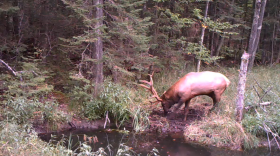Wisconsin hunters need to know the difference between a deer and an elk.
Wisconsin has two elk herds that have been established.
The Clam Lake Elk Range lies within the Northern Forest Region of Wisconsin and comprises portions Sawyer, Ashland, Bayfield, Price and Rusk Counties.
The Black River Elk Range is located in the Central Forest region of eastern Jackson County.
Elk occasionally venture outside of Wisconsin’s two elk ranges, especially during the fall breeding season.
- Adult elk are larger than adult deer. An adult elk stands about 1-2 feet taller than an adult deer at the shoulders. An elk calf will be about the same size as an adult white-tailed doe but will display similar coloration to adult elk.
- Spot the difference in the antlers. White-tailed deer antlers curve forward, whereas elk antlers are larger and sweep back from their heads.
- Look for color markings. Elk have a tan rump patch, black legs and a dark brown mane. Deer have legs the same color as their bodies, a white throat patch and a fluffy white tail.
- Additional markers. Elk moving throughout the state may have noticeable markers, including colored ear tags or tracking collars. These collars are fixed around the neck and are typically orange in color, sometimes with a visible printed number.
If you shoot an elk without a tag to take one, you could be fined and lose your hunting privileges.
Wisconsin’s archery deer season opens Saturday.






